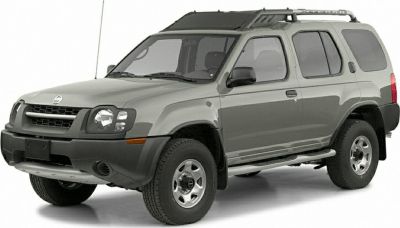 2003 Nissan X-Trail I (T30, facelift 2003) Dimensions, Size & Specs
2003 Nissan X-Trail I (T30, facelift 2003) Dimensions, Size & SpecsMeasurements of the 2003 Nissan X-Trail I, engineered for optimal performance and comfort
| Dimensions | |
|---|---|
| Length: | 4455 mm175.4 in14.6 ft |
| Width: | 1765 mm69.5 in5.8 ft |
| Height: | 1675 mm65.9 in5.5 ft |
| Trunk Capacity: | 410 liter14.5 cu ft |
| Trunk Capacity (Max): | 1841 liter65.0 cu ft |
| Weight Specifications | |
| Curb Weight: | 1380-1525 kg3042-3362 lbs |
| Maximal permitted Weight: | 2000-2050 kg4409-4519 lbs |
| Roof Load: | 100 kg220 lbs |
| Tire Specifications | |
| Rims Sizes: |
|
| Tire Sizes: |
|
The Nissan X-Trail I (T30) facelift edition from 2003, produced until 2007, is a compact SUV that blends practicality with rugged styling. This model features a length of 4455 mm (175.4 inches), a width of 1765 mm (69.5 inches), and a height of 1675 mm (65.9 inches), positioning it comfortably within the competitive compact SUV segment. Its curb weight ranges from 1380 kg to 1525 kg (3,042 to 3,362 lbs), depending on configuration and trim, with a maximum weight capacity between 2000 and 2050 kg (4,409 to 4,519 lbs), making it capable of carrying both passengers and cargo reliably.
One of the standout features of the 2003 facelifted X-Trail is its versatile luggage capacity: it offers a standard boot volume of 410 liters (14.5 cubic feet), which expands significantly to 1841 liters (65 cubic feet) when the rear seats are folded down, catering to different passenger and cargo needs. The roof load capacity is rated at 100 kg (220 lbs), allowing for additional storage options such as roof boxes or sporting gear.
The vehicle is equipped with 15- or 16-inch rims, fitted with tires sized 215/70 R15 or 215/65 R16 respectively, balancing on-road comfort with off-road capability. This first-generation X-Trail after the 2003 facelift preserves a strong and functional design ethos typical for Nissan SUVs, ideal for both urban commuting and outdoor adventures. The combination of moderate dimensions, versatile interior space, and a solid weight profile contribute to its reputation as a durable and user-friendly SUV in the early 2000s market.
Discover the standout features that make the 2003 Nissan X-Trail I a leader in its class
Have a question? Please check our knowledgebase first.
The Nissan X-Trail I (T30, facelift 2003) measures 4455 mm (175.4 inches) in length, 1765 mm (69.5 inches) in width, and 1675 mm (65.9 inches) in height. These dimensions position it well within the midsize SUV category, offering a balanced footprint that facilitates urban driving while still providing ample interior space. The relatively moderate width ensures easier maneuverability on narrower streets and parking spaces, while the height offers elevated driving position and interior headroom for passengers.
Yes, the Nissan X-Trail I (T30, facelift 2003) generally fits into a standard residential garage. Most single-car garages have a width ranging from 2400 mm to 3000 mm (94.5 to 118 inches), and heights around 2100 mm (82.7 inches) or higher. Given the X-Trail's width of 1765 mm (69.5 inches) and height of 1675 mm (65.9 inches), it leaves sufficient clearance on both sides and above. However, the driver should still measure their specific garage dimensions and consider additional space needed to comfortably open doors and maneuver around the vehicle.
The Nissan X-Trail I (T30, facelift 2003) provides a practical luggage capacity of 410 liters (approximately 14.5 cubic feet) when the rear seats are in their upright position, suitable for everyday shopping or small luggage. When the rear seats are folded down, the capacity expands significantly to 1841 liters (around 65 cubic feet), offering a versatile and spacious cargo area for larger items, bulky gear, or extended travel needs. This flexibility makes the X-Trail a practical choice for families and outdoor enthusiasts alike.
The curb weight of the Nissan X-Trail I (T30 facelift 2003) ranges between 1380 and 1525 kg (approximately 3042 to 3362 lbs), while its maximum weight is between 2000 and 2050 kg (4409 to 4519 lbs). This moderate weight ensures a balanced combination of stability and fuel efficiency. A lighter curb weight generally aids in more agile handling and better acceleration, whereas the maximum weight indicates how much load the vehicle can safely carry including passengers and cargo. The X-Trail's weight supports confident driving both in urban environments and on light off-road terrains, maintaining the SUV's versatility without compromising comfort.
The 2003 Nissan X-Trail I (T30 facelift) uses tire sizes 215/70 R15 and 215/65 R16 mounted on 15- or 16-inch rims respectively. The 215 mm width provides a good balance between grip and comfort, while the profile and rim sizes ensure a smooth ride with adequate handling characteristics. The different rim sizes offer some options depending on trim or preference—15-inch rims tending toward comfort and 16-inch rims providing a slightly sharper handling response. These tire and rim options reflect the vehicle's design as a practical SUV with moderate off-road capabilities.
Since the 2003 facelift marked a revision within the first generation Nissan X-Trail T30 itself, there is no previous generation to compare directly before 2000. However, compared to the pre-facelift T30 (2000-2003), the facelifted model retained very similar dimensions including the length of 4455 mm (175.4 inches), width of 1765 mm (69.5 inches), and height of 1675 mm (65.9 inches). The facelift primarily focused on styling updates and interior refinements rather than dimensional changes, maintaining the vehicle's established footprint and practicality that made it popular in the midsize SUV segment.
In comparison to similar midsize SUVs from the early 2000s like the Toyota RAV4, Honda CR-V, and Mitsubishi Outlander, the Nissan X-Trail I (T30 facelift 2003) is slightly larger overall. With its length of 4455 mm (175.4 inches) and width of 1765 mm (69.5 inches), the X-Trail offers a more spacious interior and cargo capacity. For example, the 2003 Toyota RAV4 was shorter and narrower, while the Honda CR-V of that time was similar but generally had a smaller luggage area. This extra space in the X-Trail lent it an advantage for families and those needing enhanced utility, while still remaining compact enough for practical daily use.
The roof load capacity of the Nissan X-Trail I (T30 facelift 2003) is rated at 100 kg (221 lbs). This means the vehicle can safely carry additional cargo like roof boxes, bikes, or luggage racks without compromising stability or safety. For families, adventurers, or anyone needing extra hauling capability beyond the internal luggage space, this roof load limit provides useful versatility and expands what the X-Trail can transport on trips or outdoor activities. It is important to distribute roof loads correctly and stay within the recommended limits to maintain good driving dynamics.
The Nissan X-Trail I (T30 facelift 2003) comes equipped with 15- or 16-inch rims paired with 215/70 R15 or 215/65 R16 tires, respectively. The slightly larger 16-inch rims offer a sportier feel with better handling precision, while the 15-inch rims emphasize ride comfort and absorb road imperfections more effectively. The 215 mm tire width balances grip and rolling resistance, optimizing fuel efficiency and stability. Overall, these tire and rim configurations make the X-Trail a comfortable yet capable SUV, suitable both for city driving and mild off-road conditions.
The varying curb weight of the Nissan X-Trail I (T30 facelift 2003), which ranges from 1380 kg to 1525 kg (3042 to 3362 lbs), depends on different trim levels, optional equipment, and drivetrain configurations (front-wheel drive vs. four-wheel drive). Heavier variants tend to include additional features such as all-wheel drive, reinforced chassis components, and extra comfort or safety equipment. This variance affects fuel consumption, acceleration, and handling characteristics. When choosing a specific model, buyers should consider which weight class best suits their driving needs, balancing desired features with performance and efficiency.
Discover similar sized cars.

| Production: | 2014-2018 |
|---|---|
| Length: | 4500 mm177.2 in |
| Width: | 1820 mm71.7 in |
| Height: | 1730 mm68.1 in |

| Production: | 1999-2002 |
|---|---|
| Model Year: | 1999 |
| Length: | 4515 mm177.8 in |
| Width: | 1785 mm70.3 in |
| Height: | 1740 mm68.5 in |

| Production: | 2000-2004 |
|---|---|
| Model Year: | 2000 |
| Length: | 4522 mm178.0 in |
| Width: | 1790 mm70.5 in |
| Height: | 1763-1895 mm69.4-74.6 in |

| Production: | 2019-2021 |
|---|---|
| Model Year: | 2019 |
| Length: | 4451 mm175.2 in |
| Width: | 1735 mm68.3 in |
| Height: | 1677 mm66.0 in |

| Production: | 2020-2022 |
|---|---|
| Model Year: | 2020 |
| Length: | 4500 mm177.2 in |
| Width: | 1824-1842 mm71.8-72.5 in |
| Height: | 1746 mm68.7 in |
